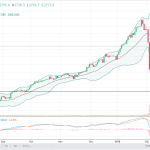
The US dollar is mostly consolidating yesterday’s move. Sterling is pushing back through $1.29 as the hawks on the MPC may not have been dissuaded by disappointing PMI readings and the softer earnings growth. The table is being set for another 5-3 vote at next month’s MPC meeting.
The Australian and New Zealand dollars are up about 0.6%, gaining nearly twice as much as sterling. The risk-off sentiment, softer yields in the US and Europe, and strong Chinese import data are among the drivers. The Australian dollar surged through the $0.7700 level to challenge a 15-month down trendline that is found near $0.7725.The high for the year was set in March at $0.7750.
China reported a 17.2% year-over-year increase in imports. The median forecast in the Bloomberg survey was for a 14.5% pace after 14.8% in May. Exports rose 11.3%, up from May’s 8.7%, and stronger than expected. The trade surplus rose by more than a third from a year ago to $42.8 bln.China’s surplus with the EU is 60% larger at $11.4 bln, while the trade surplus with the US is nearly 90% larger at $25.4 bln.
Two elements are politically charged. The first is China’s steel and aluminum exports. Steel exports slipped to 6.81 mln tons from 6.98 mln in May. Unwrought aluminum and aluminum product exports were unchanged at 460k tons. The second is a trade with North Korea. Chinese figures point to an 11.3% decline in imports from North Korea in H1, which includes the period before sanctions were implemented. Chinese exports to North Korea rose by nearly 30%, but note that not all goods are sanctioned, and these are consumer goods, like textiles.
Many observers looked at the decline in US bond and note yields and concluded Yellen was dovish. However, we note that the best guide for Fed policy is not the coupon curve but the short-end. The cleanest is the Fed funds futures. The September contract was unchanged for the third consecutive session. It is unchanged since the US jobs data last Friday, and the implied rate is half a basis point lower than it was at the end of June. It is also at the same level it was at from June 16 through June 29. There has been no real change in the market’s expectation.












Leave A Comment